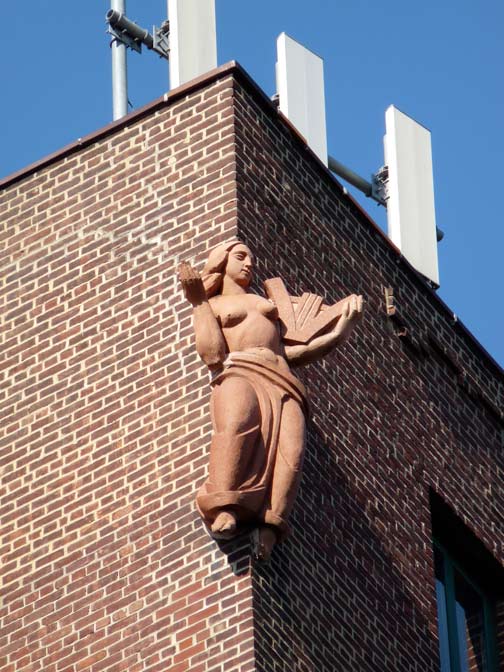I have an undying fascination with Parkchester — it’s not just another housing project, but a mini-city plopped in central Bronx, with its own shopping strip and movie theater. Some residents need not ever leave it for days at a stretch. You can get there by taking the #6 train to its namesake station.
It has its own whimsical art direction, as well, with numerous, playfully-executed terra cotta sculptures, most of them located high on buildings, so you have to look up to see them; but occasionally there’s one closer to the ground. The Metropolitan Life Insurance Company, which built Parkchester beginning in 1941, chose the Federal Seaboard Terra Cotta Corporation for the project. The company supplied over 500 statues of hula girls, accordion players, farm animals, and other unique accoutrements as doorway ornaments, as well as elaborate designs for theatres and storefronts, some by renowned sculptor Joseph Kiselewski.
For many more views of Parkchester’s sculptures, see this FNY page.
1/2/13


4 comments
As in many of your photographs, there is always a contrast of the old and the new; in this case, a beautiful piece of terra cotta sculpture sitting about six feet below an array of what appears tp be cell phone equipment.
I’ll take the sculpture anyday!
My maternal grandparents were among Parkchester’s original residents. My late father-in-law worked for the outfit that poured the concrete. I was born & raised there. My parents lived there until 1977 when they relocated to Queens. You’re right about Parkchester being a very selfcontained community. In my childhood trips to other parts of the Bronx were like journies to despair. At the time of my family’s departure there was still no possibilty of airconditioning which was why I had settled in Flushing in 1972. It’s interesting to see the statues coexisting with the cell towers.
My family moved into parkchester in 1943. I went to PS 106, Herman Ridder Jr. HS, Performing Arts HS for a semester and then James Monroe. I had a necklace made of a single strand of yarn that had my house key and my skate key on it. I still have the skate key. On weekday mornings I’d cross the street t go to grade school and then to the playground for marbles, or jacks, or trading cards or roller skating and didn’t go home until the streetlights came on. I loved living there until 1963 when I moved to my own apartment in Manhattan. My parents stayed there until 1967 when they moved to Miami Beach.
We lived down in Peter Cooper while I had aunts and uncles living in Parkchester in the 1960s, and it was interesting to contrast and compare the differences in Met Life’s architecture between their pre-war complex in the Bronx, and their post-war Peter Cooper and Stuyvesant Town development in Manhattan. Outside of the fountains on Stuyvesant Oval, the building designs in the post WWII developments (along with Met Life’s Riverton in north Harlem) were more minimalist, with no exterior flourishes other than a few tweaks to the building entranceways.
They foreshadowed the large post-war housing project designs of Robert Moses, albeit with better amenities than both Parkchester and the Moses projects, as Met Life took lessons from their first site and added things to their Manhattan units (though I always thought it odd that Met Life spent the $$$ to wire Peter Cooper for air conditioning from the outset, while Stuyvesant Town tenants had to swelter until major rewiring work was done in the 1990s).